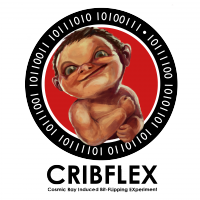By Tamela Maciel at the APS April Meeting in Baltimore, Maryland

Little bits: the CRIBFLEX logo. (Courtesy: Drexel University Society of Physics Students)
A group of undergraduate students at Drexel University in Philadelphia is ready to click “confirm” on an Amazon order that will include a weather balloon, a memory storage device, a GPS, a Geiger counter and a BeagleBoard computer (described to me as a “beefier version of Raspberry Pi”). For less than $2000, this team of physics, engineering and computer-science students plans to launch a weather-balloon experiment that will measure the effects of cosmic rays on DRAM memory devices at high altitudes.
The team is part of the Drexel University Society of Physics Students and the members presented their experiment design at the April Meeting of the American Physical Society in Baltimore, Maryland, last weekend.
DRAM is a very quick and simple type of electronic memory – each bit takes the form of a capacitor that either has charge or doesn’t, according to whether it’s storing a zero or one. Unfortunately, this simple design can make the bits very sensitive to radioactivity or cosmic rays, which can cause bits to flip values and introduce “soft errors” into the data.
On the ground, these errors are rare because the atmosphere is very good at shielding us from cosmic rays. But both the flux and energy of cosmic rays increases at higher altitudes, so soft errors can be a problem for computers on mountain tops, in aeroplanes and on spacecraft.
While the relationship between bit flipping and cosmic-ray flux is known for relatively low altitudes, there is still uncertainty as to what happens higher up. The Drexel group plans to address this by launching a custom-built memory storage device on a weather balloon this June. The project has been funded by a Chapter Research Award from the Society of Physics Students, which is a national organization in the US.
“The idea of putting up a balloon is such a crazy idea. It’s all the details: finding helium, contacting the FAA [Federal Aviation Administration],” says Ed Callaghan, one of the team leaders. The first-year students say that learning how to conduct a research project while they’re just starting their physics studies adds an extra challenge.
After launch and an estimated 29 km flight, a road trip might be necessary to retrieve the balloon – the group says it could land up to 500 km away from the launch point. The team will spend rest of the summer analyzing the data.
“Hopefully in a year we’ll be back with our graph,” Callaghan told me.
Trackback: Mozilla Science Sprint 2015 – Open Data Formats for Cosmic Rays |